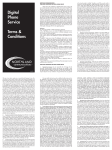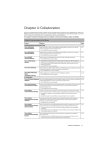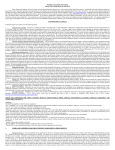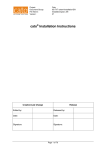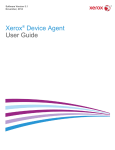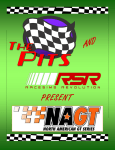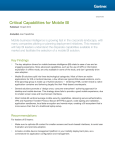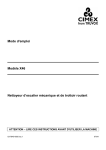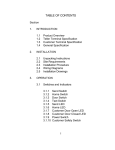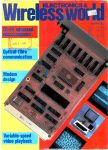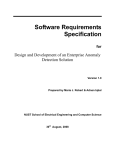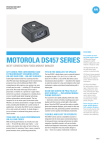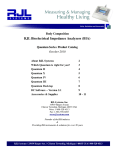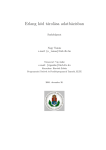Download if you want to improve your customers` experience, say tuvox now.
Transcript
WHITE PAPER BEST PRACTICES IN PROVIDING SUPERIOR CALLER EXPERIENCE WITH SPEECH “IF YOU WANT TO IMPROVE YOUR CUSTOMERS’ EXPERIENCE, SAY TUVOX NOW.” DELIVERING A SUPERIOR CALLER EXPERIENCE THAT CUSTOMERS PREFER TO USE A recent Gartner study indicates that most customers prefer speech to both touch-tone and the Internet for self-service. The study also revealed that if wait times were more than two minutes, callers strongly preferred using speechenabled self-service applications to speaking with a representative. This is good news for enterprises that recognize the value of automation in reducing costs. Self-service technology can also meet customer expectations for improved service and increased satisfaction. However, not all speech applications are created equal. Some are highly frustrating, causing the caller to unnecessarily repeat information or to wade through endless hierarchical menus before arriving at a place where self-service can finally begin. In order for speech applications to deliver a superior caller experience, they must take a conversational approach that enables callers to ask for what they need, understand their question and quickly resolve their problem. Clearly, natural language must be a key component of any preferred speech application. The speech application must further enable callers to engage successfully in a variety of call types such as routing, completing transactions and resolving product support issues. A sophisticated natural language speech application is one that is easily customized to an enterprise’s business needs and can deliver a caller experience so good that callers actually choose it over a live agent because they can get the information they need quickly. For callers to prefer using a speech application, they need to be able to ask for what they want and to feel in control of the process. For example, they should be able to say, “What’s my account balance?” or “I need help setting up my DVD player.” They will feel in control of the process if they are able to issue commands such as “wait”, “go back”, “next”, or “live agent” at any time. On the enterprise side, many companies would like to offer a differentiated customer service to their high value customers. A robust speech application should provide the capability of identifying VIP customers and handling the call according to enterprise processes. For example, routing the call consistently to the same agent, or asking if the customer is following up on the issue they called on in the last 48 hours. If a caller needs to speak with a live agent, the interaction must be productive. The agent should already have access to all the information the caller has provided to the speech application. Nothing is more annoying to a caller than inputting all account information into the system and, after failing to resolve the issue, being routed to an agent who asks for the same information all over again. SPEECH WITHIN REACH Contents The Formula for Success in Caller Adoption _____ p.3 Caller Adoption _________________________ p.4 Choice ______________________________ p.4 Quality ______________________________ p.4 Blending Automation with Agents ___________ p.4 Conversational Techniques _________________ p.5 Caller in control _______________________ p.5 More flexible grammars with Natural Language _ p.5 Open-ended routing: How may I help you? _____ p.5 The Value of Rapid Tuning Cycles _____________ p.6 Quickly identify hot spots where callers experience problems ____________________ p.7 Call Path Optimization ___________________ p.7 TuVox Delivers High Caller Satisfaction in All Types of Calls ________________________ p.8 Call routing___________________________ p.8 Transactional calls _____________________ p.9 Customer Support calls __________________ p.10 Speech Application Deployment and Maintenance _ p.10 TuVox Complete Lifecycle Approach [Reduces Errors and Improves Predictability] _________ p.10 Predictive Recognition __________________ p.10 BulletProof Deployment __________________ p.10 Maximum Uptime and Improved Caller Experience _______________________ p.11 Conclusion ____________________________ p.11 Where to Go for More Information ____________ p.11 The TuVox Difference _____________________ p.8 VUI (Voice User Interface) Components ________ p.8 Rapid Update ___________________________ p.8 p.2 TRUE SPEECH-ENABLED SYSTEMS ARE NO LONGER BOUND “ W H AT ’ S M Y A C C O U N T B A L A N C E ? ” BY THE CONSTRAINTS OF A 10-DIGIT KEYPAD. THE FORMULA FOR SUCCESS IN CALLER ADOPTION Advances in speech technology offer the ability to automate more than touch-tone dialing and improve customer satisfaction through a higher quality caller experience. As one call center manager said, “I can easily achieve a 100% call deflection rate…all I have to do is shut off access to live agents!” Obviously, that is not a satisfactory approach if you want your customers to remain customers. Companies were also hesitant about subjecting their customers to speech applications, concerned that a bad experience would reflect poorly on the enterprise. To break through these adoption barriers, it is critical to overcome the persistent problems of previous approaches to building, managing and maintaining speech applications. You can create a high quality caller experience only if you meet the following criteria: • Provide conversational, open-ended call routing— let the caller tell you why they are calling. Despite the promised benefits of speech automation, • Provide a high quality, intuitive user interface the process of deploying a speech application has and clear, understandable prompts while taking historically been a barrier due to: a best practices approach to error handling • High costs resulting from many and recovery. specialized resources. • Ensure the caller can speak as naturally as is • Lengthy deployment cycles practical without causing recognition errors. (typically nine months or more). • Integrate seamlessly to the live agent so that if • High costs of ongoing maintenance the caller needs to exit automation, the agent with heavy reliance on vendor support. will know exactly what happened—or the next time, the caller will probably press zero at the The process of deploying, managing and start of the call. maintaining a speech application resulted in a • Provide personalized/customized experiences high total cost-of-ownership, and was therefore based on class of customer, caller intent, etc. daunting to all but the largest enterprises. p.3 By increasing automation, you give your callers a way to get answers without tying up a live agent. In addition, by providing a seamless handoff to a live agent, call resolution rates can drop significantly. More automation drives down call center costs, staffing costs, outsourcing costs and facility costs—making a win-win for both customers and enterprises. Two additional factors to consider are the cost of on-going maintenance for the speech applications, and updating the speech applications as your company introduces new products and your call center agents update the knowledge base. Companies in the decision-making process often overlook these ongoing costs, placing too much emphasis on evaluating initial purchase costs and not enough on the cost of maintenance and updates. You need to consider all of these factors to ensure that the speech automation system you deploy makes your company more profitable, not less. WHEN PROVIDED WITH A CHOICE, CALLERS ACTUALLY CHOOSE AUTOMATION WHEN THE WAIT IS LONGER THAN TWO MINUTES. CALLER ADOPTION In order to drive caller satisfaction while achieving the highest possible automation rates: 1. The caller must be given the choice to use the automated system 2. The system must provide a high-quality, reliable experience, and 3. There must be seamless blending of automation and agents. In the following pages we will explore what is required for a quality, highly adopted speech system, as well as how TuVox enterprise speech applications provide these features for a superior caller experience. CHOICE With any automated system, the perception of choice is critical in gaining buy-in from the end user. In speech applications, callers must feel that they have the choice to use it, and can at any time change their mind and speak to a live agent. In the “real world” we have this choice in front of us at all times, whether we choose to exercise it or not. At the bank, at the airport and at the gas station, we know that if we need assistance a real human being is only a few steps away. automation when the wait is longer than 2 minutes. As an example, imagine choosing whether to wait in line for a boarding pass from a ticket agent, or whether to use a self-service kiosk at the airport. In this case, a “visible queue” might influence your decision to use the automated kiosk. But what about the “invisible queue” on a telephone? In implementing speech automation, it is critical to let your callers know how long the wait is. Even if you choose to push every call to the automated system regardless of queue times, your callers should know that they could reach an agent at any time by saying “live agent” or “operator”. QUALITY The second factor that drives adoption of speech applications is the quality of the application. This encompasses a wide range of issues, from the quality of audio (no static, constant volume level) to the quality of the application (does it correctly recognize what the caller says?) to the quality of voice talent (does it match the persona of the company?). Each of these elements plays a role in how favorably your callers perceive the system. In addition to the quality of the audio and voice, customers demand a reliable and consistent experience. If ATMs constantly short-changed bank Similarly, with a speech application callers should customers, there would be a mass migration know that they always have the option of speaking inside the banks to deal with reliable human with a live agent. This serves the dual purposes of tellers. Similarly, speech applications must provide reducing frustration and increasing user confidence the same level of repeatable experience. When a caller says, “I need help using my MP3 player”, the with the system. Further, if callers know that the alternative is less attractive (e.g., long wait times) call should be routed accurately and consistently to a resource that can assist, whether it be an they will be more inclined to adopt automation. When provided with a choice, callers actually choose automated system or a live agent. p.4 IVR (Interactive Voice Response) systems have failed to deliver a quality customer service experience because they are built on a hierarchical decision model that can only provide limited options to callers. These systems force callers to listen through an endless number of menus before getting to the option that will enable them to take care of their issues. BLENDING AUTOMATION WITH AGENTS As stated previously, callers should always have the choice to speak with a live agent. Once transferred, it is critical to pass along all call information to the agent, including the full transcript of what was said in the automated system. As a result, the agent can immediately pick up where the speech application left off and callers do not feel they have wasted time in the automated system. If they have to start all over with the agent, there’s a good chance they will not even try the automated system the next time around. For streamlined caller-agent interaction, call center agents must be presented with key information such as customer account number, caller phone number, wait time and reason for calling in as seamless a way as possible. Relevant call information should appear in the agent desktop application, case management system or browser window. The agent should also have options for transferring the call to specific points in the system, without losing any callerentered data. Companies place too much emphasis on evaluating initial purchase costs and not enough on the cost of maintenance and updates. CONVERSATIONAL TECHNIQUES CALLER IN CONTROL Built in to the human psyche is the desire to be in control of our situations. Think of the person in the back seat of a taxi as the driver recklessly weaves in and out of traffic. No one longs to repeat experiences over which we had no control. Similarly, no one enjoys being forced to endure poorly designed speech applications with no hope of escape. Fortunately, it is relatively easy to put the control into the hands of your callers. By ensuring the speech application includes navigational commands like wait, continue, next, go back, repeat, help, main menu and good-bye, you give callers the ability to navigate around and at their own pace. More importantly, you increase their level of satisfaction with the system. what they want in their own natural speech pattern leverage Natural Language and provide a preferred conversational speech experience that is more likely to be used. TuVox speech applications are Natural Language based and provide flexible grammar capability that can understand and find the right response by leveraging computational linguistics that does not do a key word search, but actually understand the meaning of words and phrases. To ensure consistency across the application, TuVox builds in an “assistant” to quickly update the words and phrases that the application can understand. For example, making sure “tech support” equates to “technical support” or “product support” across the entire application. TuVox also provides flexible options for callers to select a choice. Some callers may not know what TuVox speech applications include caller in control words they can say to the system, so they prefer a features that provide the commands: wait, continue, directed dialog approach to call routing. Directed next, go back, repeat, help, main menu and good- dialog provides options for specific choices and bye, giving the caller the ability to navigate around “more choices” exposes less common selections. and at their own pace. OPEN-ENDED ROUTING: HOW MAY I HELP YOU? MORE FLEXIBLE GRAMMARS WITH Think of how many times you have heard the NATURAL LANGUAGE phrase “please listen carefully because our options Human beings do not speak like robots. Humans have changed.” One of the inherent limitations of are polite (even to automated systems) and a traditional touch-tone IVR is the way it groups and well-designed speech application should be able presents a series of options to callers. Consider to understand conversational questions and the following: statements such as: “I’d like to…” or “I’m calling • For personal checking, savings or money market about”, or “Tell me what my…” and so on. This accounts, press 1. provides a much more pleasant, natural experience, • For business checking and business line of and increases the level of caller satisfaction. credit accounts, press 2. Speech applications that allow callers to ask for p. 5 THE SPEECH APPLICATION SHOULD PROVIDE INTUITIVE, GUIDED MENUS TO SUGGEST OPTIONS SPECIFIC TO THE CALLER. • For home mortgages, equity lines of credit and current interest rates, press 3. • For credit card accounts including payment information, press 4. • For branch locations and hours of operation, press 5. • To repeat these choices, press 6. • To speak to a representative, press 0. Each of these menu options sounds similar, and each leads to a sub-menu with even more choices. This type of system forces the caller to memorize a list of items and make real-time comparisons with the reason for their call. It cannot handle questions such as “What happens if my choice is not listed?”, “What if I press the wrong key?”, “What was option 1 again?” and “How do I get out of this system?” It would certainly be easier to simply say “Did you get my last payment?” or “What’s my account balance?” and then the speech application identifies the appropriate routing. If the caller’s question results in more than one match, the system should be smart enough to ask, “Did you want your checking or savings account balance?” If the caller is a new customer or just doesn’t know what to say, the speech application should provide intuitive, guided menus to suggest options specific to the caller. Open-ended routing completely changes the style of a touch-tone or “press or say 1” type of application, allowing callers to describe in their own words what they are calling about. If designed with the caller in mind, it can also shorten call times and drive increased caller satisfaction. TuVox speech applications provide conversational, open-ended routing, as well as fallback “guide me” menus to help callers when they are not sure what to say. Additionally, TuVox call routing applications automatically generate clarifying menus to further refine the caller’s intent if they request a general topic; for example, “calling plans.” In this case, the system would respond with something like, “OK, I have several types of calling plans…What plan would you like to hear about?... local, long distance or international?” TuVox call routing speech applications let callers use a natural, open-ended conversational approach to identify what they want, then route them to the desired skills-based agent pool, other voice self-service application, or touch-tone application. TuVox’s call routing approach replicates the experience of talking to a live agent. Instead of forcing callers to follow a rigid, sequential menu, TuVox allows callers to interact using a conversational approach, in their own words. This approach allows callers to resolve their issues and complete their transactions quickly and easily, reduces misdirection and misroutes, and therefore improves caller satisfaction. THE VALUE OF RAPID TUNING CYCLES As we have seen, true speech-enabled systems are no longer bound by the constraints of a 10-digit keypad. Because callers can now say in their own words the reason for calling, more and broader functionality can be added to the system. Your speech application now becomes a primary way of solving customer problems as quickly as they arise. p. 6 To ensure the highest level of customer service, speech applications must be as dynamic as your knowledge base and Web self-service, and must be updated as frequently as other key customerfacing applications. During the course of developing, piloting, deploying and tuning an application, you will likely go through dozens of tuning cycles. Keep in mind that each tuning cycle involves traversing the entire “lifecycle” of a speech application, from development to testing, deploying and reporting. Historically, a tuning cycle has taken weeks. However, today’s best-in-class speech applications require a tuning cycle of only hours or a few days. Ultimately, this means that you can quickly add new content (new catalog numbers, new products, updated knowledge base and FAQs) to keep up with the enterprise business. Much of traditional tuning revolves around deploying an application, taking phone calls and using live callers as guinea pigs to find places where the application mis-recognizes what the caller said, confusing one word for another. TuVox’s Predictive Recognition leverages intensive algorithms (similar to those used in DNA analysis) that use a phonetic lexicon to compare each potential response (grammar) against every other grammar response, and reports spoken options that may be confused with each other; e.g., Austin, Boston, Houston in a travel application. Predictive Recognition saves a tremendous amount of time in this area, reducing what may take days or weeks into an analytical process that can be run by the developer in a matter of minutes. Speech applications must be as dynamic as your knowledge base and Web self-service, and updated as frequently as other key customer-facing applications. Ultimately, the caller benefits because even an initial pilot application is far more robust, and tuning can focus on more subtle caller behavior. TuVox provides an integrated environment that allows you to tune the speech application in days and includes built-in best practices and VUI component services that ensure rapid and bulletproof tuning of the speech application using your internal IT resources. Your enterprise no longer requires outside speech consultants to update and tune the application. The TuVox component services include built-in features such as dialog generation from enterprise content, caller in control, DTMF (Dual Tone Multi-Frequency) fallback, lost caller detection and predictive recognition that automates many of the speech application tuning cycle steps that were previously done through custom coding. QUICKLY IDENTIFY HOT SPOTS WHERE CALLERS EXPERIENCE PROBLEMS Callers may ask for the same thing using different words. A sophisticated speech application should detect and identify these “hot spots” where callers experience problems. Consider the following example: A manufacturer recently sent out a shipment of products without the user manual inside the box. Although the manufacturing issue was quickly detected and resolved, it still drove a large number of incoming calls to the call center. Callers said things ranging from “Where’s the manual?” to “I don’t have a user guide” to “How do I set this thing up?” Within hours, enhancements to the company’s speech application enabled it to listen for those phrases and handle the calls accordingly. p. 7 Previously, the call center manager had noticed a large number of “no match” errors from callers at a certain point in the application. In this case, the hot spot was in the main menu. Once the manager identified and added the reason for these calls, the hot spot went away. TuVox provides an integrated application and grammar development environment, combined with underlying extensive logging and reporting tools. You can quickly evaluate deployed applications to identify hot spots. This makes it far easier and faster to find the grammar that needs to be updated and tuned for better performance and increased caller satisfaction. Built-in “assistants/wizards” allow developers to easily make changes to the spoken options that will be recognized by the system. TuVox’s Reporting Portal captures detailed information about each call, including “No Match” and “No Input” events (places where callers said something the system didn’t understand, or didn’t say anything at all, respectively). The Reporting Portal generates reports that allow fast drill downs to isolate areas in the application where these types of events occurred. Enterprises can then evaluate whether a grammar and/or prompt should be modified for improved performance. CALL PATH OPTIMIZATION As callers are using the system and data is gathered, enterprises can make adjustments to enhance the usability of the speech application. Understanding why callers are calling can help with the design of a speech application by showing TUVOX’S CALL ROUTING APPROACH REPLICATES THE EXPERIENCE OF TALKING TO A LIVE AGENT. the most common paths visited by callers. This allows changes, for example, to make it easier to get to a commonly visited topic. It also offers business intelligence value, by indicating why and who is calling. This becomes particularly valuable for companies who want to offer a superior and differentiated service experience to their VIP and high-value customers; for example, routing a platinum customer directly to an agent who is assigned to that customer. THE TUVOX DIFFERENCE This paper outlines best practices for superior caller experience, and the dramatic difference between traditional touch-tone systems and the enterprise speech applications that TuVox offers. Among TuVox differentiators are Natural Language, open-ended routing, rapid tuning cycles, Predictive Recognition and superior customer experience. Let’s examine more closely how TuVox delivers this. VUI (VOICE USER INTERFACE) COMPONENTS TuVox component services include built-in features such as dialog generation from enterprise content, caller in control, DTMF (Dual Tone Multi-Frequency) fallback, lost caller detection and Predictive Recognition that automate many of the steps in the design, development, testing, deployment and tuning of speech applications. This saves VUI designers, application developers, grammar specialists and QA testers the necessity of manually designing in these features. In addition, these built-in component services also dramatically improve the voice user interface. For example, you can import enterprise content such as Web content, knowledge base and FAQs into the TuVox speech application and automatically convert it into VXML code, saving hundreds of hours in custom coding by hard to find VUI designers. RAPID UPDATE TuVox provides several rapid update capabilities like “Text-to-Topic” and “Visio-to-Topic”. By leveraging these built-in capabilities, enterprises can quickly import new information (such as new product information) into the TuVox speech application, ensuring that the speech application is ready for a major product launch. Historically, platform vendors have charged a lot of money for updating the speech application, taking up to several months to add new information. With TuVox, enterprises can reduce update time to hours, allowing an enterprise speech application to keep up with changing business. p.8 TUVOX DELIVERS HIGH CALLER SATISFACTION IN ALL TYPES OF CALLS TuVox automates routing, transaction and customer support calls. Call routing—TuVox Perfect Router™ leverages Natural Language routing which opens up the possibility of going beyond limited IVR options and supports hundreds of destination options. This allows for much greater automation and makes it far easier for callers to find the information they need based on their own description. Rather than pressing [1], then [6], then [2] to get to what callers hope is the right place, they can simply say “benefits information for chiropractic care” and jump directly to that point in the application. TuVox Perfect Router offers callers the ability to speak a very wide range of phrases to an initial prompt. more ROUTING opens up the possibility of going beyond limited IVR options and supports hun- AUTOMATION Natural language routing TRANSACTIONAL CUSTOMER SERVICE dreds of destination options. less Where do I need to go... What are my choices for... Help me find... I need to make a payment... I need to purchase a product... I need to change my address... How do I install... What is the answer to... My screen is blue... more COMPLEXITY Transactional calls—These types of calls present a higher potential for automation. They are typically more complex because callers generally go through an authentication process and, once validated, access information that is callerspecific. This requires back-end integration and, in some cases, sophisticated grammars to understand caller inputs. TuVox speech applications obtain authentication and account information from the caller and deliver information like account balances, shipment dates, or claims status. Once the caller provides information, the TuVox speech application remembers the information throughout the life of the call. The caller is never p.9 asked to repeat information already given. Once the speech application retrieves the data, the information is presented to the caller in a logical manner. Unlike a Web application that presents a screen full of information at once, TuVox speech applications speak the information to the caller sequentially. If a caller is transferred to an agent, TuVox Perfect Connect™ passes a complete transcript of the call to an agent, who can pick up where the caller left off. Callers are therefore motivated to engage with the automated system because they know that no information provided will ever need to be repeated to an agent. PREDICTIVE RECOGNITION AUTOMATES MANY OF THE S P E E C H A P P L I C AT I O N T U N I N G C Y C L E S T E P S P R E V I O U S LY DONE THROUGH CUSTOM CODING. Customer Support calls—Historically, these calls have been difficult to automate because they require complex logic to help callers solve problems, and much more dialog content than a routing or transactional application. TuVox speech applications enable companies to quickly convert training manuals, FAQs, and knowledge bases into sophisticated speech applications that mimic what a real agent would do. The TuVox speech application walks a customer systematically through complex tasks like setting up and troubleshooting products. PREDICTIVE RECOGNITION FINDS POTENTIAL RECOGNITION ERRORS BEFORE DEPLOYMENT Instead of having to wait for callers to try an application to see if there are “confusability” issues in a grammar (and turning your callers into testers), Predictive Recognition uses a unique, patent-pending approach to finding problems. Predictive Recognition phonetically evaluates grammar to see if any entries can be confused with other entries—thereby saving time, reducing errors and reducing caller frustration. For example, built-in functionality allows callers to say commands like “repeat,” “wait,” “go back” SPEECH APPLICATION and “help” anytime in the call. Similarly, built-in DEPLOYMENT AND MAINTENANCE functionality handles situations if the caller does not respond to a prompt, or says something the TUVOX COMPLETE LIFECYCLE APPROACH REDUCES system does not understand. ERRORS AND IMPROVES PREDICTABILITY These built-in best practices ensure that all Speech applications require regular “care and standard dialog conditions are handled “out of the feeding” to continually improve the caller box”, with flexibility to override all system defaults experience. TuVox streamlines and automates the as needed. manual work of traditional speech application development by providing a complete speech BULLET PROOF DEPLOYMENT lifecycle management system. Developing an enterprise speech application results in the creation of thousands of files in multiple categories, which are typically saved to a source code repository. In fact, for a typical speech application, enterprises will repeat this deployment cycle many times during the course of tuning and testing. When deploying the speech application, enterprises must ensure that the correct version of each file is checked out from the repository and reliably transferred to a staging environment for quality p. 10 Conversational techniques place callers in control, motivate them to adopt these systems and even create preference for them over waiting for a live agent. assurance (QA) testing, or to the production environment upon certification and approval. Manually configuring the application server and transferring the speech application files can result in a file deployment error, which produces call flow errors, hang-ups and other service interruptions that can result in a poor caller experience. TuVox Deployment Manager simplifies the process for deploying a speech application by reducing more than 40 manual steps for deploying thousands of files to a single click operation, dramatically improving the reliability of the application. MAXIMUM UPTIME AND IMPROVED CALLER EXPERIENCE TuVox Deployment Manager works with the missioncritical production environment to seamlessly deploy an updated application without interrupting service. TuVox also maximizes system uptime by eliminating service interruptions and unexpected disconnects that would otherwise occur if a speech application is deployed incorrectly. CONCLUSION More enterprises are looking to call center automation as a cost control measure and to improve customer experience. Traditional IVR systems are frustrating, resulting in longer call times and more live agent interventions. Speech applications that deliver a superior caller experience must therefore deliver a conversational approach so that callers can ask for what they need and the speech application must be able to understand their questions and quickly resolve their problems. Using conversational techniques p.11 that place the caller in control and flexible grammars that provide for increased levels of caller satisfaction motivates callers to adopt these systems and even creates preference for them over waiting for a live agent. Self-service systems offer cost-effective ways to provide greater levels of service and to make sure that service is available on demand. However, not all self-service applications provide the degree of flexibility, ease-of-deployment or rapid tuning cycles that can lead to enterprise profitability. Organizations need to carefully evaluate applications to ensure that they select a speech application that is flexible, powerful and will grow with their business. WHERE TO GO FOR MORE INFORMATION TuVox speech applications are built to maximize customer satisfaction while reducing enterprise self-service costs. TuVox speech applications streamline navigation, shorten time-to-resolution and offer more transactions while increasing customer satisfaction. Customer expectations can be quickly met and exceeded as the enterprise offers improved first-call resolution. TuVox’s deep understanding of call center requirements, enterprise goals and proven speech applications can provide your organization with a superior caller experience that is quick to deploy and easy to maintain. 333 Distel Circle Los Altos, CA 94022 650.623.0210 www.tuvox.com © Copyright 2005 TuVox, all rights reserved. TuVox is a registered trademark, and Perfect Agent, Perfect Connect and CVR are trademarks of TuVox Incorporated. All other names may be the properties of their respective owners.












